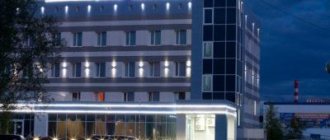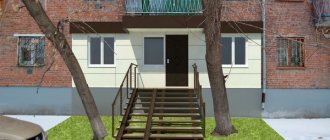What is the difference between residential and non-residential premises
The difference between non-residential and residential objects lies in the purpose of their purpose, the provision of mandatory life systems. Apartments are originally designed to house people. For this purpose, a list of hygienic, sanitary, fire, and epidemiological safety standards is provided, standards for utilities and lighting are observed, and for many other indicators. Almost all types of commercial activities are prohibited in residential premises.
Non-residential premises, on the contrary, are not used for living. The only exceptions are apartments, which are classified by law as non-residential properties. You can do business in non-residential premises. However, when placing them in apartment buildings, a number of prohibitions apply. For example, you cannot organize harmful production or sale of potentially dangerous goods.
The transfer of residential premises to non-residential premises is permitted by the Housing Code of the Russian Federation. But this requires obtaining the consent of the owners of neighboring apartments and copyright holders of the apartment buildings, and confirming the safety of the upcoming work during approvals. There are also a number of technical limitations under which it will be impossible to change the intended purpose.
Lawyer's comment . The main purpose of transferring housing to non-residential stock is to remove restrictions on commercial activities. In non-residential premises you can open offices, shops, organizations with other activities. The reverse procedure is also allowed, in which you can make an apartment from a non-residential premises. But this is even more difficult, since it is necessary to ensure compliance with living conditions.
The transfer of an apartment to non-residential premises is always accompanied by redevelopment. All types of work and changes in characteristics will be reflected in the redevelopment project.
Which premises are considered non-residential?
It is worth highlighting the main types:
- Office-type premises that are used to support the work of office employees;
- Retail premises are a variety of shops and buildings with a similar purpose;
- Premises used for storing goods;
- Production, industrial complexes;
- Sports buildings;
- Premises with free use.
Why do apartment owners want to sell to people who are interested in opening a store? It's all about the value of the apartments that are located on the ground floor. This is where you can most often find modern shops or children's playrooms.
When is transfer allowed?
The conditions and grounds for transferring residential premises to non-residential premises are regulated by the Housing Code of the Russian Federation. Here are the most important points to know:
- the premises must be on the first floor (you can transfer the apartment from the second floor if the premises below it are already non-residential);
- from the non-residential premises there is access to the street area (for example, through the entrance group, stairs);
- the transfer must be approved by the owners of all neighboring apartments , including those above (this new rule has been in effect since 2019, and may become an insurmountable obstacle);
- consent to the transfer must be given by 2/3 of the rights holders of the entrance and the apartment building (for this, an in-person, absentee or in-person meeting in absentia is appointed);
- There are many prohibitions regarding the characteristics and types of translation work that must be observed in the project.
Find out more Relocation from dilapidated and emergency housing
This is only a general list of rules that accompany the process of changing the intended purpose. When performing work, it is prohibited to worsen or limit the living conditions for residents, seal ventilation, cut off the supply of utilities, or violate sanitary standards. In Moscow there is a special list of permissible and prohibited types of work during redevelopment. This can become a problem during approvals.
Fire safety standards deserve special attention. For this reason, it is prohibited to sell flammable materials, pyrotechnics, and a number of other dangerous goods in non-residential premises of apartment buildings.
For non-residential premises you need to make a separate exit to the street. To do this, partitions inside the apartment are removed, a new exit opening and porch are installed.
Who can transfer an apartment to non-residential premises
This is a very important point that not everyone knows about. Only owners can transfer residential premises to non-residential premises. If there are several of them, then the consent of each co-owner of the property is required. This may cause problems if the share belongs to a child. Since as a result the apartment will cease to exist in the legal sense of the word, the guardianship authorities must agree to deprive the child of housing. Usually, this requires purchasing another apartment of equal cost and area.
Tenants or tenants of housing do not have the right to dispose of real estate, including making decisions to change its status. To implement the transfer, you must first privatize the apartment, if the tenant has the right to do so. The transfer will also require the consent of the mortgagee if a mortgage is registered on the apartment. A typical example is a mortgaged apartment on which there is an encumbrance in favor of the bank.
Legal advice . The translation procedure is quite lengthy, and it is very difficult to guarantee the successful completion of approvals. Often, purchasing non-residential premises in the same building or a nearby facility will cost less. To calculate all possible risks and assess the feasibility of further actions, contact our experts for help.
This is what a separate exit for a non-residential premises might look like. Pay attention to the entrance group.
The procedure for transferring to non-residential premises in Moscow
Let's look at how to transfer an apartment to non-residential premises in the form of step-by-step instructions. The algorithm for the reverse procedure will be largely the same. The result of both options is the introduction of changes to the Unified State Register of Real Estate in terms of new characteristics and status of the premises.
Owners' decision and documents
As stated above, it is impossible to proceed to the main stages of approval until consent (permission) has been received for the translation from all copyright holders of the apartment and owners of the premises of the house. The procedure is as follows :
- written consent is issued from the co-owners of the living space, whose data is indicated by the Unified State Register of Real Estate ( if there is only one owner, this is not required );
- consent is taken from the owners of neighboring apartments;
- a meeting is appointed and held with the participation of the owners of the apartment building ( the final protocol must contain 2/3 votes “for” from the copyright holders of the premises of the house and entrance ).
Find out more How to register ownership of a land plot
Already at this stage, you can show the project for the upcoming work in order to convince voters that the redevelopment is safe. Since the construction of a new exit affects the load-bearing structures of the apartment building, increased attention is paid to the safety of the upcoming work.
The redevelopment project can be ordered before agreement with the owners of the house. But if they refuse, no one will return the money for the design.
Redevelopment project
All work planned for transfer to non-residential premises must comply with building codes and standards. To ensure this compliance, a project is ordered and approved. The contents of the document reflect :
- parameters of the premises before the start of work (they are obtained based on the results of surveys and study of documents);
- the regulatory framework on which redevelopment is designed;
- justification for redevelopment decisions that make it possible to convert housing into non-residential;
- list of safety measures for work;
- requirements for building materials, equipment, tools;
- graphic materials for work (diagrams, plans);
- estimates, calculations.
The exact list of solutions and works will be determined according to the customer’s technical specifications. The project is manufactured only by companies included in the SRO of designers.
When carrying out work, you must strictly follow the project and the law, and not violate the interests of the neighbors of the house.
Technical report in Moscow
You can convert an apartment into non-residential premises by working on the load-bearing structures of the apartment building. Therefore, it is necessary to ensure their reliability, strength, and stability. For this purpose, it is necessary to order a technical report on the condition of the structures . This document can be ordered from the authors of the MKD project, or from a specialized expert organization. In the capital, such an organization is the State Budgetary Institution “Expert Center”.
The technical report states whether it is possible to carry out the work taking into account the actual state of the structures, what safety measures the designer and contractor must take into account. Based on the contents of the document, it is possible to provide measures to strengthen structures and determine requirements for the type and quality of materials. The technical report and the project will be checked by housing inspectorate officials.
Coordination of the transfer of housing to non-residential premises
A decision (notification) on the transfer of residential premises to non-residential premises is issued by the DGI (Department of State Property) . The Moscow Housing Inspectorate checks documents for redevelopment, compliance with permissible and prohibited work, and the availability of mandatory consents. The verification period does not exceed 45 days. To avoid problems, you can act through a representative with experience in approvals.
After transferring the apartment to non-residential premises, it is necessary to coordinate with the owners of the house the placement of signs and advertising structures.
Technical plan and cadastral registration
Translation work entails changes in the characteristics of the object. Walls can be removed or erected, space can be redistributed between different rooms, doorways can be expanded, and other changes can be made. They must be reflected in the Unified State Register of Real Estate, since this register contains information about all real estate. The final stage includes actions :
- after completion of the work, you need to contact the Moscow Housing Institute and obtain a certificate;
- it is necessary to submit documents to the BTI in order to make changes to the registration certificate;
- you need to obtain a technical plan from a cadastral engineer;
- after inspections and determination of the characteristics of the premises, a technical plan will be issued;
- With the technical plan, you need to contact Rosreestr or the MFC and undergo cadastral registration.
Find out more Project for redevelopment of an apartment in an apartment building
A project for transfer to non-residential premises will be needed at the stage of acceptance through MZhI . Officials will check that the new space features are in line with the design. If compliance is confirmed, a transfer order is issued. After registration in the Unified State Register, the intended purpose will be changed - instead of “apartment” the designation “non-residential premises” will appear. The registry will also be updated with information about the characteristics of the object. The owner will receive an extract from the Unified State Register and will be able to begin commercial activities, taking into account the restrictions for apartment buildings.
Expert commentary . Transfer to residential premises requires ensuring compliance with sanitary, epidemiological, fire, and other standards. For this purpose, a kitchen is built (if it was missing), a bathroom is equipped, and living space and lighting standards are brought into compliance. Also, apartments usually do not have access to the street. Therefore, when transferring, you need to make an exit to the entrance by dismantling a separate porch or staircase.
At the redevelopment stage, you can immediately make a ramp on the porch, since this is a mandatory requirement for all commercial properties.
How to convert commercial real estate into residential property?
The opposite situation is also possible if they want to turn an office into an apartment. The procedure is the same, but there are some subtleties
. The same list of documents and a similar application will be required. It is submitted to the local government body and considered in accordance with the general procedure.
The premises that need to be converted to residential status must meet the requirements
, listed in Decree of the Government of the Russian Federation dated January 28, 2006 N47:
- placement in a residential area;
- working condition of load-bearing structures;
- provision of utility networks (electricity, water supply and sewerage, heating and ventilation, in some cases gas supply);
- sanitary and epidemiological safety;
- if the room is located above the 5th floor, there must be an elevator.
And other requirements: there are many of them. But if the office was previously an apartment, then there should be no problems returning to its original state
. In this case, the minutes of the general meeting and the consent of adjacent owners of the premises are not required.
What problems may arise during translation?
As stated above, reconciliation of translations is an extremely complex procedure. The following problems may occur:
- refusal by the owners of the apartment, adjacent premises, apartment buildings for translation and redevelopment work;
- inability to ensure safety standards, which threatens the stability and strength of the house;
- unsatisfactory condition of structures, which impedes work;
- impossibility of circumventing work bans during redevelopment.
In each specific case, you need to decide how to circumvent these difficulties. For example, the refusal of the owners of apartment buildings to give consent cannot be appealed . Therefore, the customer will have to look for a compromise and convince him to agree, otherwise all subsequent stages will not make sense. Restrictions on construction work can be circumvented by choosing other solutions and refusing individual changes.
Is it permissible to transfer a residential building to a non-residential building?
The purpose (functional) purpose of buildings may also change. In this case, the transfer of the housing stock to non-residential is possible if all the apartments in the apartment building are resettled. After resettlement, the owner of the building will become the owner of all premises and will make decisions about the future fate of the property.
Coordination may include obtaining permission for reconstruction if such work is carried out. If redevelopment is sufficient for the transfer, it does not need to be approved in a non-residential building. The functional purpose of the building must be changed through Rosreestr.
At the final stage, the owner will receive an extract from the Unified State Register. In this example, the intended purpose of the object is “residential premises, apartment”. After all approvals, it will be changed to the status of “non-residential premises”.
Duration and cost of procedures
Let's look at how much it costs to transfer an apartment to non-residential premises and how long this procedure will take:
- the stage of obtaining consent from the owners of apartment buildings can take up to 1-2 months, and costs will be associated with organizing and holding the meeting;
- registration of the project takes from several days to 1-2 weeks, and the cost of design work is determined by contract;
- the cost and timing of drawing up a technical report is also determined by agreement with an expert organization;
- approval at the Moscow Housing Institute takes up to 45 days, and there is no state fee for the procedure;
- a technical plan can be obtained in 1-5 days, and the cost of work is determined by agreement with a cadastral engineer;
- making changes to the Unified State Register is free of charge, within 12 days.
Additional costs may be associated with support of approval procedures. Preliminary prices for services and documents of our company can be viewed in the table below.
What requirements must an apartment meet?
Technical:
- It is possible to organize a separate entrance to the premises;
- There is no need to use main gas supply;
- There are no non-residential premises under the apartment.
Legal:
- There are completely no legal encumbrances - this could be a mortgage loan, or, for example, rental debts;
- The apartment is not collateral; it has not been seized by bailiffs;
- You are the owner of the apartment, now no one is registered here;
- 67% of other people who live in this house agree that you sell the apartment for non-residential premises.
What requirements must the building meet:
- There are no plans for a major reconstruction of the building;
- No one is going to tear the house down;
- The building is not considered emergency.
conclusions
- The transfer of premises from residential to non-residential is permitted if such work is agreed upon with the owners of the apartment building and permission is obtained from the Moscow Housing Inspectorate.
- Permission to transfer residential premises to non-residential premises is issued on the basis of the project and technical requirements. conclusion, minutes of the meeting of residents of the house.
- To obtain approvals, you must comply with the restrictions and prohibitions specified in the Housing Code of the Russian Federation and regional regulations.
You can learn more about the nuances of approvals from our real estate experts.








